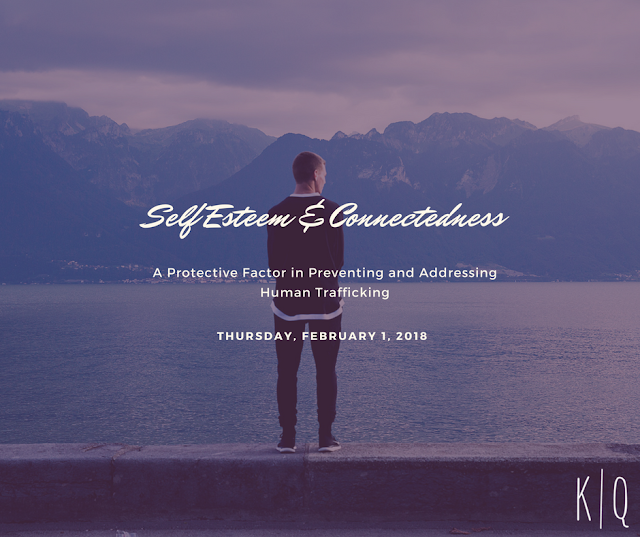Self Esteem and Connectedness: A Protective Factor in addressing and combating Human Trafficking
In our rapidly expanding world that is prone to technology use shouldn't we feel more connected, more socially fulfilled than ever before? We unfortunately, we don't. In our world where technology and social media appears to be connecting us all closer together, more people are experiencing extreme loneliness and disconnectedness then ever before. This lack of connectedness is concerning for both obscure and obvious reasons, especially in the school setting. What is the impact on student's when they feel that they have a unconnected, and an unfulfilled place in an learning environment, and in their spheres of influence in general, and for that matter what even is school connectedness? Well, The Center for Disease Control (CDC) defines school and social connectedness as, "the belief held by students that adults and peers in the school care about their learning as well as about them as individuals" while also identifying school and social connectedness as an invaluable protective factor in preventing students from becoming involved in certain risky behaviors. Well I am sure you are saying to yourself, "okay, school connectedness sounds great, but how do I build connectedness, and what are the benefits of this work?" Keep scrolling and we will discuss this and more.
But first a quick side note on protective factors: these are variables that will support a child and an adolescent be able to cope effectively with specific challenges, and risk factors that they are presented with prior to reaching adulthood. With an increase in the presence of protective factors comes a child's more effective ability to deal with and prevent certain challenges and health risks from becoming significant adversities that they then must overcome. For a further discussion on protective factors and their importance check out this overview by the U.S. government (which will also provide further resources for research).
But after you do the world to create this 'connectedness' what can you expect to see trend wise within your student body and youth that you spend time around? Well among a significant list of benefits, students in a connected environment are, "are less likely to use substances, exhibit emotional distress, demonstrate violent or deviant behavior, experience suicidal thoughts or attempt suicide, and become pregnant". These effects have been found to be universal to students regardless of their current academic performance highlighting that students of all academic backgrounds want to feel engaged and feel as if they are valued within the classroom and the learning environment as a whole. Studies have also found that when students feel more connected they are less likely to skip school and will be more likely to graduate-- an obvious incentive to increase school connectedness for educational administrators and cultivate a culture of connectedness in our school system as a whole.
In addition to these benefits, when our students feel more connected they are more likely to build positive and healthy relationships with a figure that they consider to be a trusted adult. This being a person that the student can take guidance and seek social-emotional support from. Students who have this relationship with a parent, guardian, teacher etc. and have support will be, according to researchers at the University of Sydney, more resilient, and therefore less likely to run away from home, feel socially lonely/isolated, and because they have a positive adult relationship be more likely to make positive decisions.
However, without this positive sense of connectedness and therefore an elevated sense of positive self-esteem, student are more likely to engage in risky behaviors, such as sending inappropriate photos of themselves to others, and even running away from home. Unfortunately, according to the Colorado Department of Human Services homeless youth will be actively recruited for sexual exploitation or other forms of human trafficking within 48 hours of leaving home, this perpetuating the issue of human trafficking and teenagers being sold in sexual slavery and engaging in 'survival sex'.
Now back to school connectedness. First of all, how do we (and especially educators) foster a sense of connectedness in a school? The CDC, again, identifies six creative ways of making students feel more connected in their schools (check out page two of the attached PDF). This list includes: engaging family units in a student's learning and adjusting teaching practices to foster a trusting and accepting environment for students to learn in. These, and other strategies identified by the American Psychological Association are invaluable when cultivating the positive effects of an interconnected school.
This is a shocking realization and it puts the importance of investing in youth and in students into perspective. Not only does creating a connected environment for your children and your students prepare them to maximize their potential, but it also minimizes their likelihood of engaging in risky behaviors and possibly ending up in a trafficking situation. Increasing our youth's access to adults and promoting a positive relationship with those adults should be at the top of our list if we are serious about protecting, and investing in the future leaders, doctors, teachers, moms and dads, authors, and famers of our world. Creating a sense of connectedness, to negate their growing sense of loneliness is a comparatively simple fix to the massive issues youth in America and around the world face today. We have to make the effort to reduce student:adult ratios in all environments, and maximize parent's ability to connect with their children. If connectedness is a way to prevent trafficking and numerous other adverse circumstances from happening to our students, why not take the opportunity?
In conclusion I ask you how will you engage with the youth around you, and how will you connect your environment in the pursuit of promoting the invaluableness of each student's potential and worth to secure a better future for all?





Comments
Post a Comment